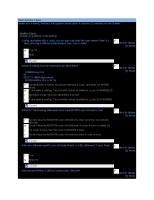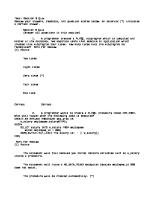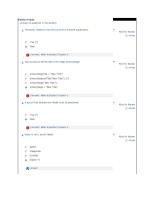Section 5 Quiz
Test: Section 5 Quiz Review your answers, feedback, and question scores below. An asterisk (*) indicates a correct answe
Views 1,722 Downloads 18 File size 79KB
Recommend stories
- Author / Uploaded
- Ariya Dc
Citation preview
Test: Section 5 Quiz Review your answers, feedback, and question scores below. An asterisk (*) indicates a correct answer. Section 5 Quiz (Answer all questions in this section) 1.You execute the following code: DECLARE CURSOR emp_curs IS SELECT last_name FROM employees; v_last_name employees.last_name%TYPE; BEGIN OPEN emp_curs; LOOP -- Point A FETCH emp_curs INTO v_last_name; EXIT WHEN emp_curs%NOTFOUND; DBMS_OUTPUT.PUT_LINE(v_last_name); END LOOP; CLOSE emp_curs; END;
Mark for Review (1) Points
At Point A (after you have OPENed the cursor) another user updates an employee's last_name from 'Smith' to 'Jones' and immediately COMMITs. When your block FETCHes this row, which value will be fetched and displayed? Jones Smith (*) Smith and Jones (the row will be fetched twice) No value will be displayed An INVALID_CURSOR exception will be raised when you try to FETCH the row. Correct 2.What will happen when the following code is executed?
Mark for
DECLARE CURSOR emp_curs IS SELECT salary FROM employees; v_salary employees.salary%TYPE; BEGIN FETCH emp_curs INTO v_salary; DBMS_OUTPUT.PUT_LINE(v_salary); CLOSE emp_curs; END;
Review (1) Points
The execution will fail and an error message will be displayed. (*) The lowest salary value will be fetched and displayed. All employees' salaries will be fetched and displayed. The first employee's salary will be fetched and displayed. Correct 3.Place the following statements in the correct sequence: A. OPEN my_curs; B. CLOSE my_curs;
Mark for Review (1) Points
C. CURSOR my_curs IS SELECT my_column FROM my_table; D. FETCH my_curs INTO my_variable; C,D,A,B C,A,B,D C,A,D,B (*) A,C,D,B Correct 4.Which of these statements about implicit cursors is NOT true?
Mark for Review (1) Points
They are opened and closed automatically by Oracle. They are declared by the PL/SQL programmer. (*)
They are declared automatically by Oracle for all DML statements. They are declared automatically by Oracle for single-row SELECT statements. Correct 5.A cursor is declared as: CURSOR c IS SELECT * FROM departments FOR UPDATE; After opening the cursor and fetching some rows, you want to delete the most recently fetched row. Which of the following will do this successfully?
Mark for Review (1) Points
DELETE FROM c WHERE CURRENT OF c; DELETE FROM departments WHERE CURRENT OF c; (*) DELETE FROM c WHERE CURRENT OF departments; DELETE FROM departments WHERE c%ROWCOUNT = 1; None of the above Correct 6Examine the . following code: DECLARE CURSOR c IS SELECT * FROM employees FOR UPDATE; c_rec c %ROWTYPE; BEGIN OPEN c; FOR i IN 1..20 LOOP FETCH c INTO c_rec; IF i = 6 THEN UPDATE
Mark for Review (1) Points
employees SET first_name = 'Joe' WHERE CURRENT OF c; END IF; END LOOP; CLOSE c; END; Which employee row or rows will be updated when this block is executed? The first 6 fetched rows will be updated. No rows will be updated because you locked the rows when the cursor was opened. The 6th fetched row will be updated. (*) The block will not compile because the cursor should have been declared .... FOR UPDATE WAIT 5; None of the above Correct 7. Consider the following cursor: CURSOR c IS SELECT e.last_name, e.salary, d.department_name FROM employees e JOIN departments d USING(department_id) WHERE e.last_name='Smith' FOR UPDATE; When the cursor is opened and rows are fetched, what is locked? Nothing is locked because the cursor was not declared with NOWAIT.
Mark for Review (1) Points
The whole EMPLOYEES and DEPARTMENTS tables are locked. Each 'Smith' row is locked and Smith's matching rows in DEPARTMENTS are locked. No other rows are locked in either table. (*) In the EMPLOYEES table, only the 'Smith' rows are locked. Nothing in the DEPARTMENTS table is locked. The whole EMPLOYEES table is locked. Correct 8. Which of the following is NOT allowed when using multiple cursors with parameters?
Mark for Review (1) Points
Using cursor FOR loops Declaring a cursor FOR UPDATE Declaring a cursor based on a join OPENing more than one cursor at the same time None of the above--they are all allowed. (*) Correct 9. Assume your schema contains 25 tables. How many explicit cursors can you declare and use within a single PL/SQL block?
Mark for Review (1) Points
As many as you need, but only one of them can be open at any time. As many as you need - there is no limit. (*) A maximum of 25 (one for each table in your schema). A maximum of three. Only one. Correct 10. Look at the following code: DECLARE CURSOR emp_curs (p_dept_id
Mark for Review (1) Points
employees.department_id%TYPE) IS SELECT * FROM employees WHERE department_id = p_dept_id; v_emp_rec emp_curs%ROWTYPE; v_deptid NUMBER(4) := 50; BEGIN OPEN emp_curs( -- Point A --); .... You want to open the cursor, passing value 50 to the parameter. Which of the following are correct at Point A? 50 v_deptid 100 / 2 All of the above (*) Correct
Section 5 Quiz (Answer all questions in this section) 11.What is one of the advantages of using parameters with a cursor?
Mark for Review (1) Points
It will execute much faster than a cursor without parameters. You can use a cursor FOR loop. You do not need to DECLARE the cursor at all. You can declare the cursor FOR UPDATE. You can use a single cursor to fetch a different set of rows each time the cursor is opened. (*) Correct 12Examine the following code. To display the salary of an employee, . what must be coded at Point A?
Mark for Review (1) Points
DECLARE CURSOR emp_curs IS SELECT * FROM employees; BEGIN FOR emp_rec IN emp_curs LOOP DBMS_OUTPUT.PUT_LINE( -- what goes here ? ); END LOOP; END; salary employees.salary emp_rec.salary IN emp_curs emp_rec.salary (*) emp_curs.salary Correct 13What is wrong with the following code? . DECLARE CURSOR dept_curs IS SELECT * FROM departments; BEGIN FOR dept_rec IN dept_curs LOOP DBMS_OUTPUT.PUT_LINE(dept_curs%ROWCOUNT || dept_rec.department_name): END LOOP; DBMS_OUTPUT.PUT_LINE(dept_rec.department_id); END;
Mark for Review (1) Points
You cannot use %ROWCOUNT with a cursor FOR loop. Nothing is wrong, this code will execute successfully. The implicitly declared record DEPT_REC cannot be referenced outside the cursor FOR loop. (*) The cursor DEPT_CURS has not been closed. The cursor DEPT_CURS has not been opened. Correct 14Which of the following statements about the %ISOPEN cursor . attribute is true?
Mark for Review (1) Points
You can issue the %ISOPEN cursor attribute only when a cursor is open. You can issue the %ISOPEN cursor attribute only when more than one record is returned. You can issue the %ISOPEN cursor attribute when a cursor is open or closed. (*) If a cursor is open, then the value of %ISOPEN is false. Correct 15Which of the following cursor attributes evaluates to TRUE if the . cursor is open?
Mark for Review (1) Points
%ISOPEN (*) %NOTFOUND %ROWCOUNT %FOUND Correct









